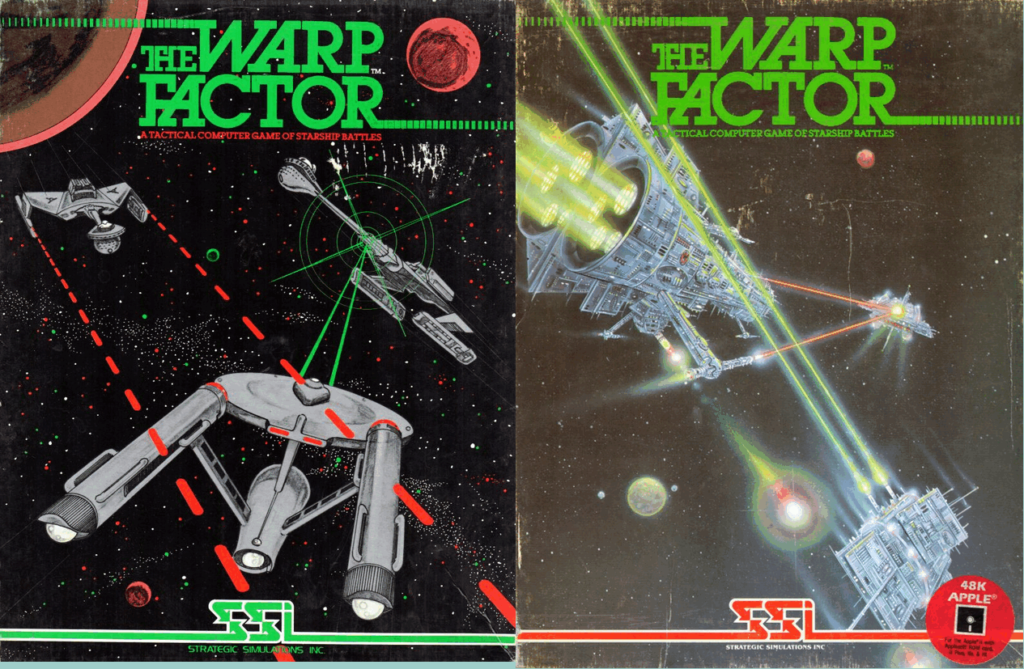
Edited on 23/12/2021 to adapt the rating to the new system. All R&R assume you have read the AAR.
Edited (introduction updated) on 21/07/2023 after discussion with the founders of Task Force Games.
The Warp Factor by Paul Murray, published by Strategic Simulations, USA
First release : February 1981 on Apple II
Tested on : Apple II
Total Hours Tested : 6-7 hours
Average duration of a battle : 1 – 2 hours
Difficulty: Average (2/5)
Would recommend to a modern player : No
Would recommend to a designer : No
Final Rating: Flawed and obsolete
The Warp Factor is SSI’s first 1981 game and its first foray into science-fiction. SSI did not take too much commercial risk though : the game is based on Star Fleet Battles, a popular board game by Task Force Games (TFG) itself using a beloved sci-fi license. Of course, the most important pitfall was the legal risk. The risk materialized, and TFG blocked SSI from attending Origins – one of the most profitable gaming conventions of the 80s – if the violation of the copyright was not compensated by a share of the profit. SSI complied, and for good measures (or maybe due to another conflict with the owners of the Star Trek licence) expunged the most egregiously ripped-off art. And so, later releases of the Warp Factor were not based on a beloved sci-fi license anymore.
Surprisingly, the game was priced at the lower $40 SSI price point (only Computer Conflict and Computer Quarterback had used this price point up until then), and indeed it came with few extras :
- The manual,
- 6 reference cards (5 factions with 2 ships by faction, and the “neutral” starbases + outpost reference card)
- 1 reference card for the scenario and, on the other side, the reference card for the speed/energy ratio of spaceships.
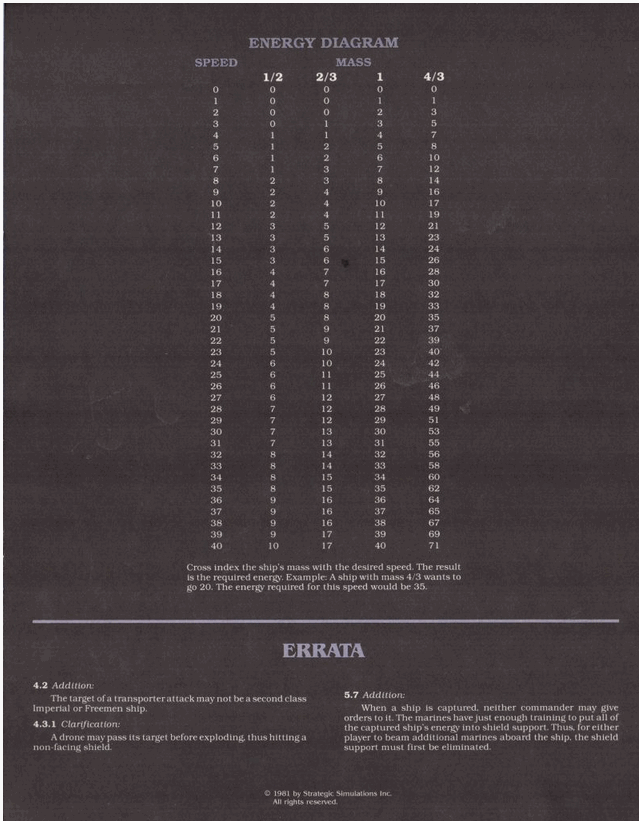
As I explained in the After Action Report, in its 1.1 version with the updated art, the game also ran faster, a handful of mistakes on the reference cards were corrected and their background was made more legible :
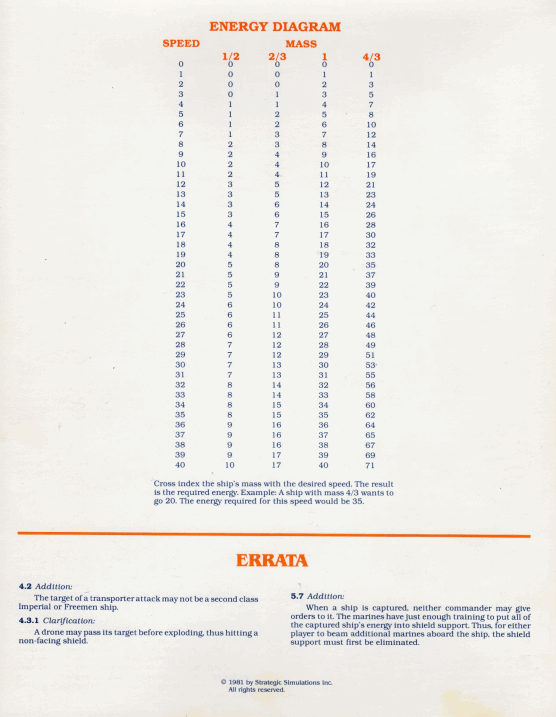
A. Immersion (Settings & Aesthetics)
How much you feel immersed in the game will depend a lot on your view of Star Trek and on whether you have version 1.0 or 1.1
In the best-case scenario, you are a Trekkie and play version 1.0. In this case, I suspect that the Warp Factor is the game you have been waiting for years and you don’t need context – you know it.
In my case, I am not much of a Trekkie, and I consider 1.1 the real version. So, this is what I have to work with :
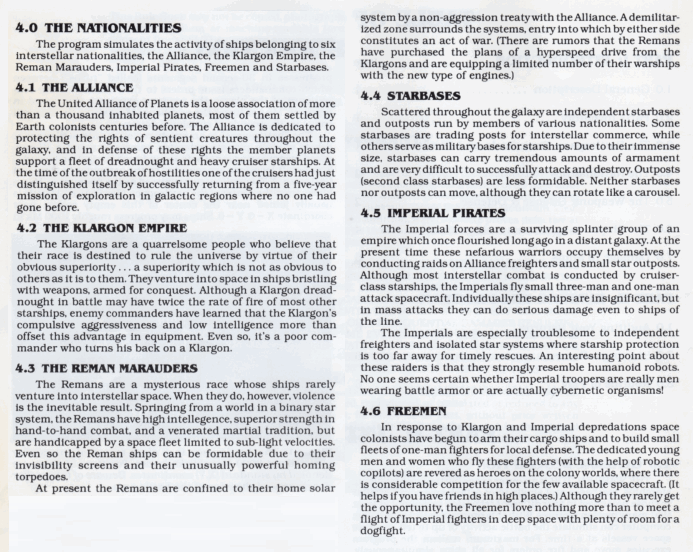
One or two paragraphs by faction, and no general context – a bit short.
The game has almost no graphics, though I really appreciate the look of the reference cards, especially in 1.0 granted.
Score : Very poor. If you are a Trekkie : adequate :).
B. Systems
The game only has a tactical layer, but it is an interesting one.
The player’s turn has two phases, after which there is a turn resolution phase.
a. The energy allocation phase
During this phase, the player allocates energy between :
- Weapons :
They are 5 types of weapons : phasers (siege, heavy or light), disruptor bolts, photon torpedoes, plasma torpedoes and drones (two types : anti-fighters and anti-capital ships).
All those weapons were featured in the AAR except one : the plasma torpedo. This weapon is unique to the Reman ships : it hits like a truck (up to 50 damage when it hits !), behaves like a drone (it is homing and survives two turns, the first turn it is fairly slow (10 Mk/turn), the second turn it is almost impossible to escape (32 Mk/turn). Unlike drones, it is not limited in number, but it needs 3 turns to charge, and must be shot the third turn (else it is lost). The balance comes from the fact that the smaller Reman ship has no other weapons, whereas the larger one can only count on four back-up phasers.
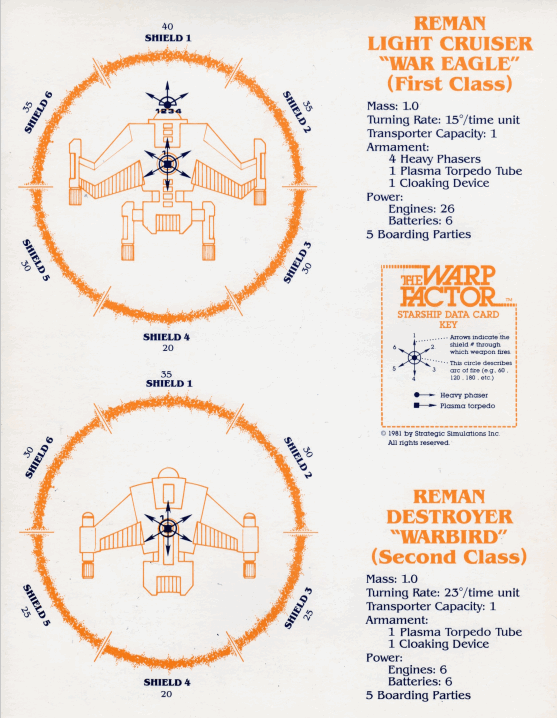
- Shield reinforcement:
Each ship has 6 shields which together form a circle. Maintaining them does not cost any energy, and as long as a shield is not destroyed, the player can allocate energy to reinforce it for one turn. Shield reinforcement can be allocated all around (at half efficiency) or to a specific shield (at full efficiency : 1 energy is one damage absorbed).

When the shield is gone, ALL damage goes through and there is no way to repair or reinforce this side.
- Movement
Just like in Invasion Orion, heavier ships require more energy to move at a certain speed. The differences are huge : to travel at speed 23 Mk/turn a fighter needs 5 energy, a dreadnought needs 40 energy. Of course, a dreadnought has typically 50+ energy and a fighter around 8 so relatively speaking it is not that different.
- ECM
A ship can allocate 0 to 6 of its energy to ECM. ECM can make individual opposing ships “fail to lock”. If they do, their accuracy is very significantly diminished. This can also make drones miss their targets.
- ECCM
A ship can allocate 0 to 6 of its energy to anti-ECCM (=Electronic Counter-Counter Measures). As the name implies, it counters enemy ECM for the ship deploying the ECCM. ECCM does not help the drones, as those are their own entity.
- Transporters
This is to beam some troops aboard an hostile ship. There is a significant advantage in defense and troops can only be beamed through destroyed shields, so it is more a “quick finish off” maneuver. Captured ships cannot move or attack,
- Cloaking device (Reman ships only)
Reman ships cannot attack while cloaked, but their enemies don’t know their distance, speed and orientation. From my tests, attacks on a cloaked ship miss a lot more.
b. The movement & attack phase.
After energy has been allocated, the player can move and attack with their ship :
- Movement is in 16 time units, as is best explained by the manual :

While accelerating and slowing down is instant, ships have a turning rate – the largest ships can only rotate by 180° in a turn.
The player can order their ships to shoot any combination of weapons, either when the enemy is below a certain range, or at a specific time unit (compared to the 16 time units of movement) or at the “last possible moment“, which is also best explained by the manual :
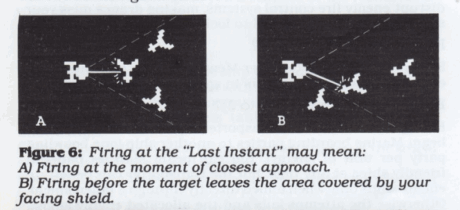
All attacks must specify a target, it is not possible to say “shoot at whatever is in range“, though of course the player can split up their attacks.

C. The resolution
Resolution is simultaneous, and sadly the player does not see the ship movements, though clearly they are done “under the hood” as when you shoot at one ship you can hit different sides (shield number) as the time units are being resolved. Excess damage (any damage that goes through a dead shield) is allocated either to useful systems or to “critical damage”. At 100% critical damage, the ship is no more.
Does it work ? I will get in it a bit more in the balancing part, but it has the same problem as many SSI “simultaneous turn resolution” games : you have no idea whether your opponent will turn right or left so there is a lot of randomness there. To be fair, it is not as crippling here as in other SSI games ; it is mostly an issue because even the most massive ships can turn relatively quickly, so it is very difficult to aim for a specific side. I feel like the game would have worked better if there had been more inertia in movement and the larger ships had turned more slowly.
Score : Adequate
C. UI , Clarity of rules and outcomes
The UI has many issues, and the game takes a bit too long to play. Every single turn and for every ship, you need to fill those entries for energy allocation :
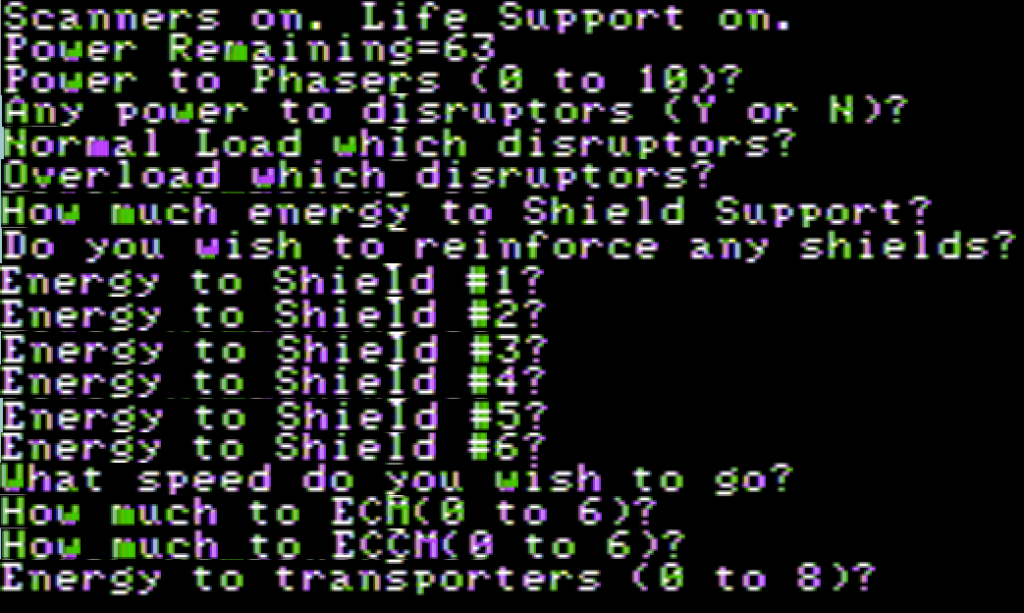
Up to 16 inputs ! The game is smart enough not to ask you about things you cannot do (eg if you don’t have any more energy, if a shield is dead, if the phasers are already loaded,…), but you can still expect 12 inputs or so every turn. You can type <Enter> to skip, but it brings me to the second problem : there is no way to change an order. if you tapped <Enter> too quickly and chose 0 in speed, you will have to do with that.
That’s for Energy Allocation alone. After that, you need to give the bearing of your ships and input the orders for shooting (targets are chosen by typing the first letter of their name). Here again, no mistake allowed : if you order your ship to shoot, you cannot roll back to check the name of your target, and if you don’t give any shoot order in the shooting menu (maybe because you expected to double-check your targets), there is no way to get to this menu a second time – you won’t shoot again.
For extra irritation, you can shoot at yourself if you input the wrong letter.
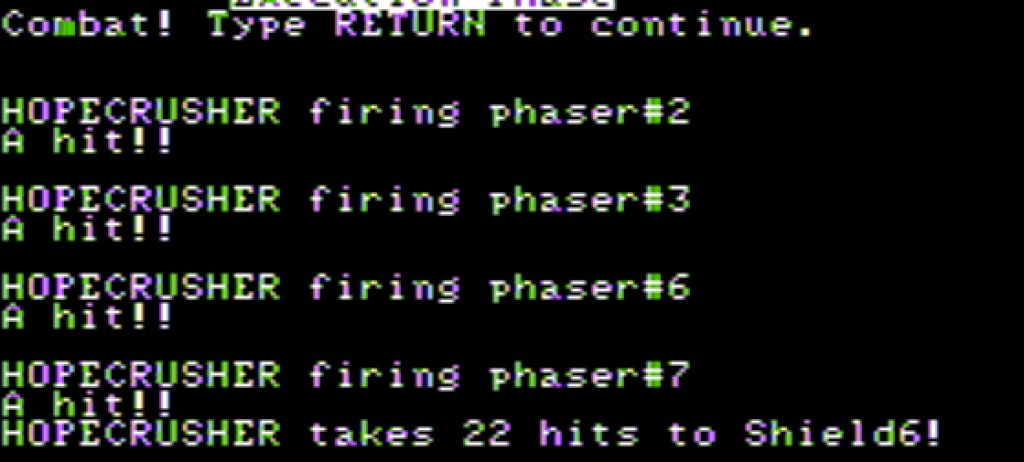
Overall, the less-than-ideal UI makes large battles involving several capital ships on your side tiresome. Much smaller ships can be managed even if they are a lot of them.
Finally, same issue as Invasion Orion : I wish I had some idea about the status of enemy ships.
Score : Very poor
D. Scenario design & Balancing
The game comes with 4 scenarios :
- A tutorial scenario where an alliance ship (with less energy than it should) must intercept a Reman Light Cruiser – actually I found this tutorial scenario very hard !
- Attack of an outpost – difficulty depends on what ships you give yourself,
- Attack of a starbase – those are extremely powerful and even with a massive fleet you will struggle,
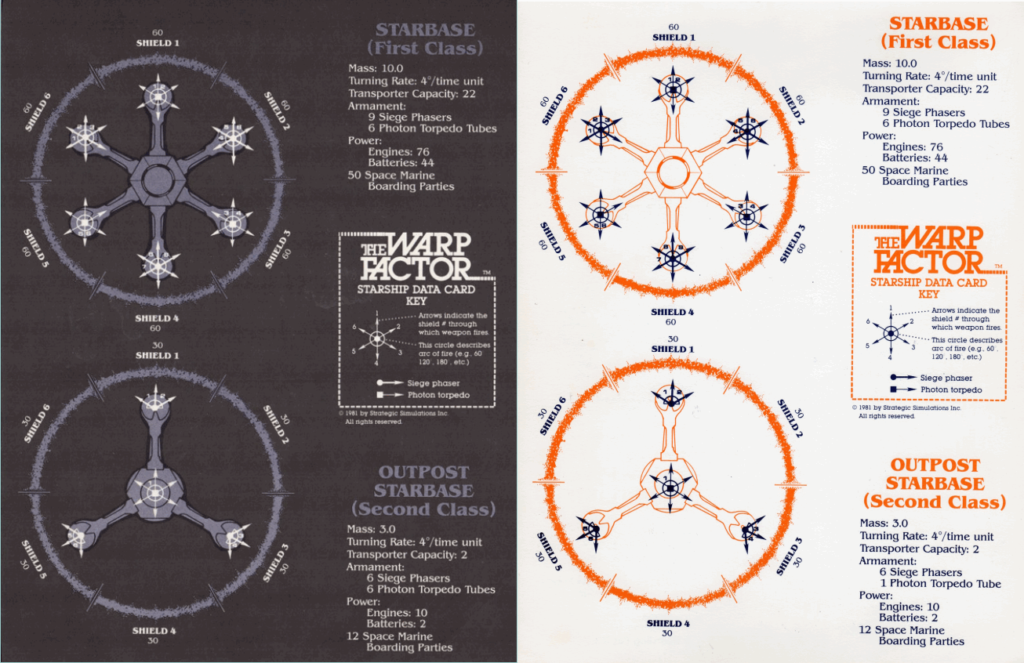
- Dogfight, where you get to choose what you have and what you fight.
The game is designed with dogfight as the main scenario, and that’s where the last big issue of the game is : it is very difficult to create interesting scenarios. Why ? Because you cannot mix factions, and each faction only has two ships available. Worse, the Remans are boring to fight or to play with (due to their cloaking device and because in practice they only shoot once every three turns).
The other ships can be divided in three categories :
- The huge ships (Alliance and Klargon dreadnoughts)
- The large ships (Alliance and Klargon cruisers)
- The tiny fighters (Imperial raiders and fighters, Freemen fighters) – with only light phasers
The only “small but not tiny” ship is the Freeman Freighter, but like the Remans it is weird to play as its only non-drone weapons are backward shooting phasers. There are no intermediate ships.
This means that the only interesting match-up are Alliance vs Klargon and Imperial vs Freemen. If you put the Imperial or the Freemen against the Alliance or the Klargons, you will need an awful lot of those tiny ships to make the battle not totally one-sided as at least one if not two fighters will be shot down every turn. The fighters simply don’t have the energy to overcharge their shield enough to withstand the cruiser/dreadnought firepower.
As for the AI, I find that it is plays solidly. It is very predictable (it always reinforces the shield facing you, it always shoots its drones at range, it tries to match your speed, it always concentrates fire on one ship even if it is a fighter that it will overkill) but it does not make silly mistakes and it offers a good challenge. There are an handful of ships that it does not know how to play, in particular the Freemen Freighter though.
Score : Poor
E. Fun and replayability
I had solid fun initially, but I quickly exhausted the interesting combinations that don’t involve too many ships. Quite a few matches were ruined by a wrong input during the Energy Allocation phase.
Score : Very poor
F. Final rating
Flawed and obsolete. Less interesting than Invasion Orion mostly due to the weakness of the scenario building.
Contemporary Reviews
As expected, the Space Gamer was the first one to cover the Warp Factor (issue 39, may 1981). Actually, the Warp Factor even made the cover of the magazine :
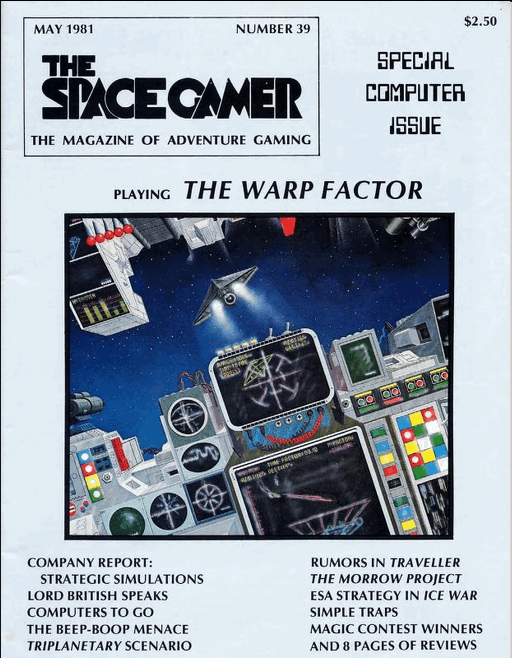
The review, by Forrest Johnson, is actually a long list of complaints and snarky comments. It starts with a mention of the similarity between the Warp Factor and Star Fleet Battles . “Presumably, the publisher has either a very good legal staff, or none at all”. After that, Johnson bemoans an “unimaginative [computer] opponent“, how easy it is to make a mistake with the input, how wrong the victory calculation is, how unbalanced the ships are, how slow the game is, how ugly the game is. And then, the final paragraph : “Still, the Warp Factor is a challenging game […] Our machine was kept pretty busy by staffers who wanted to know, for instance, how Captain Kirk would do against a swarm of Tie-fighters. It is slow, but it can keep your attention”. After this emotional roller-coaster, Steve Jackson himself signs an article on “strategy in the Warp Factor” (half the article is about training against yourself, by playing both factions).
Later reviews were less salty. Creative Computing (June 1981) calls the game “excellent” and only complains (lightly) about waiting times of several minutes during turn resolutions.
Softtalk’s review (July 1981) is even more glowing, and concludes thus : “Software reviewers have found to their sorrows that it is never appropriate to proclaim any program as the epitome of the programmer’s art for a particular genre. For as certainly as such rash proclamations are made, the very next software release will represent a quantum leap of the art. But […] it seems unlikely that the challenge and diversity of Warp Factor will soon pale.”
The anonymous reviewer from Softtalk was right to be wary of being too definitive. In 1982 Paul Murray would come back to the genre and the overall game system with the Cosmic Balance. The Cosmic Balance tries to fix the Warp Factor‘s various issues, among other by including a ship editor. In theory the Cosmic Balance will beat Invasion Orion. I will confirm that… in a few months.